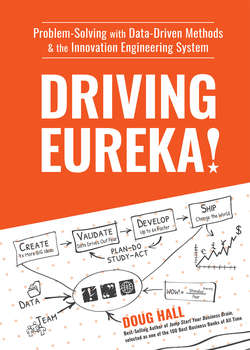Читать книгу Driving Eureka! - Doug Hall - Страница 52
На сайте Литреса книга снята с продажи.
Innovation Engineering 1.0, 2.0, 3.0, and 4.0
ОглавлениеThe development of the Innovation Engineering system has followed the same principles we teach. It’s been an iterative process of experimentation, learning, adapting, and improving. The support of thousands of managers has made it possible.
The graph on the previous page details the growth of live and active projects in the Innovation Engineering portal.
To help you understand how Innovation Engineering got to where it is today, I’ve included below a quick history of the major upgrades to Innovation Engineering (IE). As I said earlier, if you have already bought in, feel free to jump to the end of the chapter.
IE 1.0: ACCELERATING THE FRONT END OF INNOVATION. The first version of education and tools was a system focused on discovering and selecting smarter innovations to put into the organization’s existing development system. Students were supported by IELabs.com, a cloud-based internet portal that, in the case of IE 1.0, helped them create and communicate bigger and smarter ideas. The most valuable section of IE Labs 1.0 was:
Tools and Documentation: This was a toolbox of Create, Communicate, and Commercialize Tools plus step-by-step how-to guides for how to run projects. Today, this section continues to be one of the most popular parts of IE Labs.
With IE 1.0, organizations quickly went from having a lack of ideas to overflowing with ideas for growing their businesses. This created a backlog of projects. To deal with it, business executives challenged us to find ways to apply the system mindset all the way to market. This led to…
IE 2.0: A COMPLETE SYSTEM FROM IDEA, THROUGH DEVELOPMENT, TO REALITY. The move from simply idea creation to the actual work of commercializing innovations required significant upgrades in education and tools. To ensure fast startup, IE 2.0 software tools were designed to work “outside of the box” with no setup required. Then, as teams work with the software it becomes more intelligent and customized. Major IE 2.0 upgrades included:
Innovation Pipeline: A next-generation project management system was created based on rapid cycles of iterative learning instead of command and control. It’s a “smart” system that painlessly enables strategic alignment, deeper thinking, and fact-based decision-making.
Merwyn Rapid Research: A suite of research tools that result in 10X faster testing at 7% of the cost of classic research methods. This means project leaders can make smarter decisions based on hard data instead of judgment. The suite includes an artificial intelligence coaching app, risk adjusted sales forecasting, and a smart idea screener that’s been validated as being seven times smarter at evaluating innovations than business leaders at Fortune 100 corporations.
Collaboration Cafe: A digital suggestion box system that leverages the latest in psychological understanding of what ignites and constrains collaboration. The result is smarter ideas and decisions because more people are sharing more ideas and advice.
Patent ROI: A collection of tools that enable project leaders to mine 9 million public domain patents for idea inspirations, to find 250,000 flea market patents per year that can be bought cheaply, and to write a provisional patent application in about an hour.
Create, Communicate, and Commercialize Tools: Nearly 100 tools that enable everyone to think smarter, faster, and more creatively about new ideas.
IE 3.0: A SCALABLE SYSTEM FOR ENABLING A CULTURE OF INNOVATION. With IE 1.0, we were primarily enabling specialist innovation managers. With IE 2.0—taking ideas to market—we quickly found that we were touching many people across the company. And, if they didn’t have the new innovation mindset, they didn’t always understand why we were pushing for innovations that often change what they do and how they do it. What was needed was a system for enabling a culture of innovation.
With IE 3.0, we developed programs that enabled managers to quickly apply Innovation Engineering to their daily work. For example, if they are team leaders, we encourage them to innovate on ideas for helping their team work smarter immediately. IE Labs 3.0 added other important upgrades:
Innovation Metrics: This is a dashboard of real-time innovation metrics. They help leaders identify the output of their innovation system and the status of their innovation culture. New survey instruments enable leaders to understand how “future proofed” their organization is for the new world. Diagnostic data helps identify where to focus energy to improve the innovation system and culture.
Classroom Upgrade: New Innovation Engineering Blue Belt (Quick Start) course was added to the curriculum. Dozens of How-to in 2 Hours workshops were added to provide functional “how-to” learning to help people on a real-time basis.
System-Driven Leadership Course: This advanced course was totally rebuilt to greater leverage the Deming System of Profound Knowledge. A new four-step process for busting bureaucratic systems was developed from Dr. Deming’s work to help leaders deal with complex system challenges.
IE 4.0: A PERSONAL VERSION OF INNOVATION ENGINEERING. Our hopes are to engage an entire department, division, or organization in the new mindset. However, often the broader organization is not ready to change. IE 4.0 is about enabling each individual to use the tools and systems of Innovation Engineering to amplify their dreams, aspirations, and careers. A new software platform named ThinkStormer enables individuals to apply the IE mindset and methods very quickly with near-instant results.
